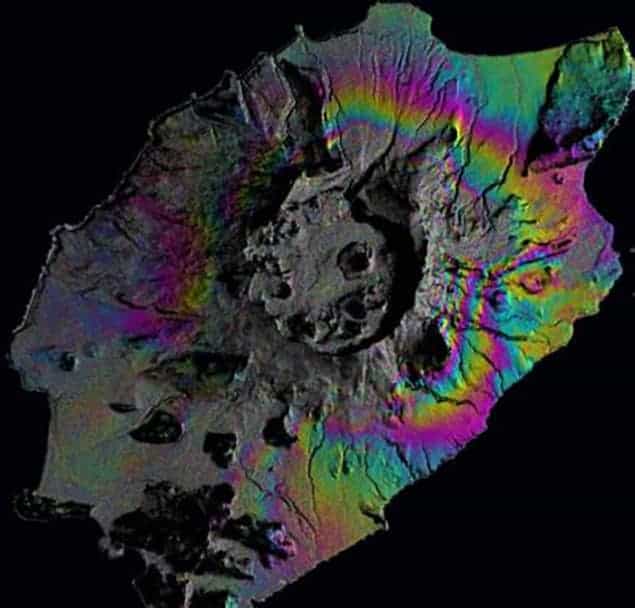
A new way of monitoring volcanic activity by integrating ongoing satellite measurements into dynamic models has been demonstrated by researchers from France. Based on data assimilation, the method might one day allow for real-time eruption forecasts in volcanic regions.
As magma moves beneath the Earth’s surface – such as under a volcano – the ground above flexes. These ground movements can be measured using both GPS and satellite-based radar data, and used to develop models of the depth and shapes underlying magma reservoirs.
A limitation of many of these models, however, is that they are kinematic in nature – focusing on motion alone. This makes them unable to yield information on the pressures of the underlying magma system. This is important in determining when a magma chamber will rupture and the volcano’s capacity to feed any resulting eruption. The surface disruption caused by a small pressure change in a large magma chamber may look identical to a large pressure change in a small magma chamber, for example – even though the latter case is more likely to lead to an eruption.
Dynamic models
To distinguish between such scenarios, volcanologists must use dynamic models that can consider how the surface displacements change with time. A small chamber, for example, would pressurize much faster than a large chamber. Most dynamic models tend to be based on data inversion and require extensive calculation and the incorporation of all observations beforehand. This makes them unsuitable for real-time eruption forecasting because they are unable to incorporate ongoing measurements.
In their new study, geophysicist Mary Grace Bato and colleagues at the Institut des Sciences de la Terre in Grenoble have addressed this issue by turning to data assimilation. This is a time-stepping approach that combines models, observations and error statistics to forecast the state of a dynamic system. Data assimilation has long been used to produce weather forecasts and predict the effects of greenhouse-gas emissions.
We foresee a future where daily or even hourly volcanic forecasts will be possible – just like any other weather bulletin
Mary Grace Bato, Institut des Sciences de la Terre
The researchers simulated the ground deformation caused by a simple, two-chambered volcanic system, and then tested the capacity of a data-assimilation approach to interpret the results. They found that the approach was able to predict the evolution of the magma pressure. It could also constrain both the shape of the deepest reservoir and the rate of the basal magma flow into this chamber – providing results comparable with existing inversion methods.
“Data assimilation offers great potential for assessing volcanic unrest,” comments Bato, concluding: “We foresee a future where daily or even hourly volcanic forecasts will be possible – just like any other weather bulletin.”
While bulletins may be some way off – and require improvements in existing volcanic models for widespread application – Bato is optimistic about the potential of data-assimilation methods in volcanology. To that end, the researchers are now looking to apply their new approach to two real-life case studies: the Grímsvötn volcano in Iceland and Alaska’s Mount Okmok.
New forecast models
“Applying cutting-edge statistical approaches to active volcanoes is the first step towards developing a new generation of volcano forecast models,” says Patricia Gregg, a geophysicist from the University of Illinois at Urbana-Champaign. Advancements such as these, she adds, “are critical to take full advantage of the excellent data made available through new satellite missions as well as data collected by volcano observatories around the world”.
“For people working in volcano observatories, it is crucial to anticipate eruptions early enough to warn local authorities. However, providing an unequivocal identification of volcano reawakening remains a challenging problem,” comments Aline Peltier, a volcanologist who works at the Piton de la Fournaise volcanic observatory on Réunion Island in the Indian Ocean, where warnings of an eruption are only possible a few hours before its onset. The potential of such complementary methods to estimate magma-chamber pressurization weeks before the event, she notes, would be “of prime importance for eruptive risk mitigation”.
The research is described in Frontiers in Earth Sciences.
- Read about how drones are being used to monitor volcanoes in the July issue of Physics World, which focuses on natural hazards



